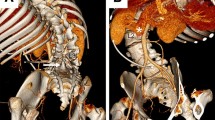Abstract
Background
Large symptomatic mediastinal seroma following modified-BT shunts, traditionally required revisional thoracotomy.
Objective
We describe percutaneous image-guided pigtail catheter drainage in the successful treatment of early mediastinal seroma secondary to PTFE Blalock-Taussig shunt, avoiding thoracotomy.
Materials and methods
A retrospective review of all relevant clinical and imaging records in five patients was performed.
Results
All five presented with intermittent stridor, respiratory distress and/or episodic desaturation within 6 weeks of their surgery. In four of five infants, percutaneous drainage was effective and reoperation was avoided. In one of five, rather than urgent surgical evacuation and BT shunt revision, we were able to perform an elective stage-II bidirectional Glenn SVC-RA anastamosis in a stable infant. There were no complications.
Conclusions
Percutaneous image-guided drainage of mediastinal seroma secondary to PTFE-BT shunt is a safe, minimally invasive, and effective treatment. This may avoid BT shunt revision.



Similar content being viewed by others
References
de Leval MR, McKay R, Jones M, et al (1981) Modified Blalock-Taussig shunt. Use of subclavian artery orifice as flow regulator in prosthetic systemic-pulmonary artery shunts. J Thorac Cardiovasc Surg 81:112–119
Bove EL SH, Kavey RE, Byrum CJ, et al (1984) Subclavian-pulmonary artery shunts with polytetrafluorethylene interposition grafts. Ann Thorac Surg 37:88–91
Al Jubair KA, Al Fagih MR, Al Jarallah AS, et al (1998) Results of 546 Blalock-Taussig shunts performed in 478 patients. Cardiol Young 8:486–490
Borrero E, Doscher W (1988) Chronic perigraft seromas in PTFE grafts. J Cardiovasc Surg (Torino) 29:46–49
Blumenberg RM, Gelfand ML, Dale WA (1985) Perigraft seromas complicating arterial grafts. Surgery 97:194–204
LeBlanc J, Albus R, Williams WG, et al (1984) Serous fluid leakage: a complication following the modified Blalock-Taussig shunt. J Thorac Cardiovasc Surg 88:259–262
Berger RM B-RG, Hop WJ, Bogers AJ, et al (1998) Heparin as a risk factor for perigraft seroma complicating the modified Blalock-Taussig shunt. J Thorac Cardiovasc Surg 116:286–292; discussion 292–293
Ozkutlu S, Ozbarlas N, Demircin M (1992) Perigraft seroma diagnosed by echocardiography: a complication following Blalock-Taussig shunt. Int J Cardiol 36:244–246
Eid A, Lyass S (1996) Acute perigraft seroma simulating anastomotic bleeding of a PTFE graft applied as an arteriovenous shunt for hemodialysis. Ann Vasc Surg 10:290–291
Tsuchida H, Kashyap A, Cameron BL, et al (1993) In vivo study of a high-porosity polytetrafluoroethylene graft: endothelialization, fluid leakage, and the effect of fibrin glue sealing. J Invest Surg 6:509–518
Ahn SS, Gupta R, Moore WS (1987) Perigraft seroma: clinical, histological, and serologic correlates. Am J Surg 154:173–178
Fink AM, Ditchfield MR (1997) Wall enhancement of leaking polytetrafluoroethylene grafts: a new CT sign. Pediatr Radiol 27:327–329
Damus PS (1984) Seroma formation after implantation of Gore-Tex vascular grafts in cyanotic children. J Thorac Cardiovasc Surg 88:310–311
Sanatani S SC, Williams W, Adatia I (2000) Sudden unexpected death in children with heart disease: who dies before the next clinic appointment? Circulation [Suppl]) 102:405
Nagae T, Tsuchida H, Peng SK, et al (1995) Composite porosity of expanded polytetrafluoroethylene vascular prosthesis. Cardiovasc Surg 3:479–484
Maitland A, Williams WG, Coles JG, et al (1985) A method of treating serous fluid leak from a polytetrafluoroethylene Blalock-Taussig shunt. J Thorac Cardiovasc Surg 90:791–793
Hiramatsu Y, Atsumi N, Sasaki A, et al (1999) A successful treatment of serous leakage from a polytetrafluoroethylene Blalock-Taussig shunt with intravenous fibrinogen administration. J Thorac Cardiovasc Surg 117:1230–1231
Author information
Authors and Affiliations
Corresponding author
Additional information
Presented at ESPR May 2000
Rights and permissions
About this article
Cite this article
Connolly, B.L., Temple, M.J., Chait, P.G. et al. Early mediastinal seroma secondary to modified Blalock-Taussig shunts — successful management by percutaneous drainage. Pediatr Radiol 33, 495–498 (2003). https://doi.org/10.1007/s00247-003-0898-5
Received:
Accepted:
Published:
Issue Date:
DOI: https://doi.org/10.1007/s00247-003-0898-5




